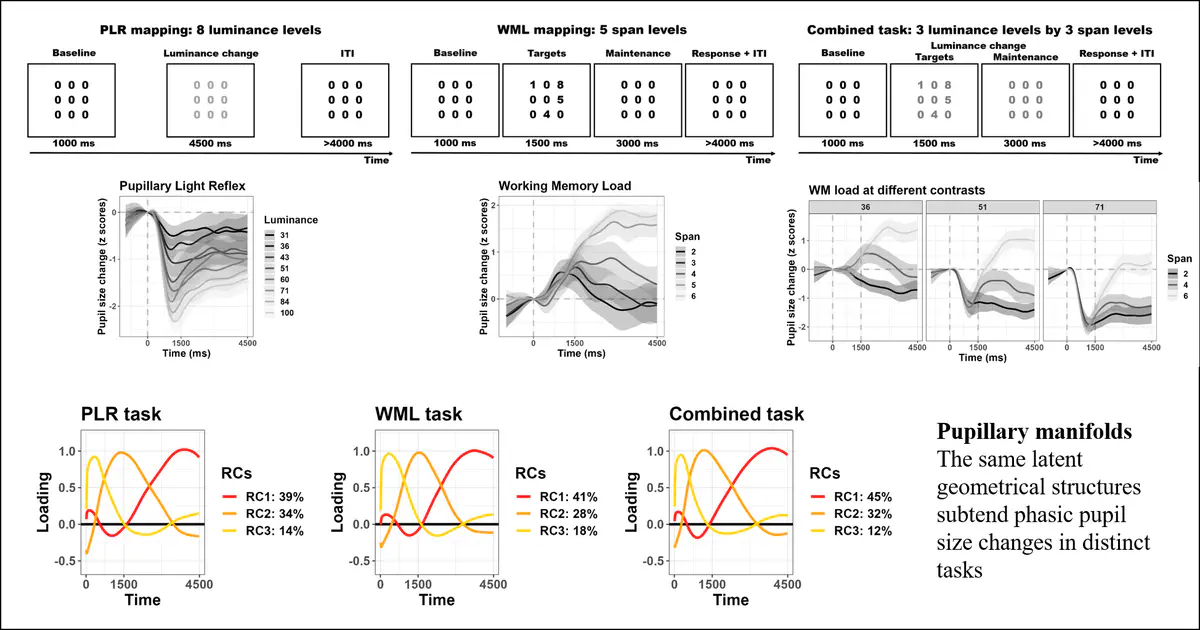 Phasic changes in pupil size are inherently low-dimensional, and stem from a set of distinctive fingerprints: Blini et al., link
Phasic changes in pupil size are inherently low-dimensional, and stem from a set of distinctive fingerprints: Blini et al., link
Hello there!
A new preprint is out! link
We have mapped, across behavioral tasks involving very different cognitive processes (i.e., reflex to light, working memory load), the latent space of phasic changes in pupil size. We have found that this space is not only low-dimensional (few components account for most of the variance), but also remarkably similar across all tasks! We suggest that this is due to hard constraints in the underlying physiological substrate – that is, the relative balance between sympathetic and parasympathetic autonomic nervous systems – which result in distinct fingerprints. These fingerprints reflect the generative processes that subtend all phasic changes in pupil size. As such, they have tremendous theoretical and practical value for the study of mental processes and neurophysiology in general. Phasic changes in pupil size are traditionally thought to reflect dynamic shifts between different attentional states as instantiated by the locus-coeruleus noradrenaline system: these shifts are crucial for adaptive behavior in that they balance explorative and exploitative actions (Aston-Jones & Cohen, 2005). In the framework outlined in the paper, these mechanisms can be accessed and described directly, with only a handful of parameters. As a result, cognitive and physiological research can find better guidance, and computational models can find more informative proxy values. From a purely methodological point of view, we also show that statistical analyses can be greatly simplified and the range of arbitrary choices greatly reduced by leveraging on dimensionality reduction.
On a personal note: this study truly is my child in that it combines the best I could gather from Lyon, Padua, and Florence. I am quite happy about how the paper currently reads, hopefully the theoretical point - which I find to be quite appealing - is made clear. Also, I could not think to a better piece to showcase ‘Pupilla’!
Looking forward to receive comments and reviews!
The full article is available on biorxiv: https://www.biorxiv.org/content/10.1101/2024.05.23.595554v1
The abstract reads:
The size of the pupils reflects directly the balance of different branches of the autonomic nervous system. This measure is inexpensive, non-invasive, and has provided invaluable insights on a wide range of mental processes, from attention to emotion and executive functions. Two outstanding limitations of current pupillometry research are the lack of consensus in the analytical approaches, which vary wildly across research groups, and the fact that, unlike other neuroimaging techniques, pupillometry lacks the dimensionality to shed light on the different sources of the observed effects. In other words, pupillometry provides an integrated readout of several distinct networks (Strauch et al., 2022), but it is unclear whether each has a specific fingerprint, stemming from its function or physiological substrate. Here we show that phasic changes in pupil size are inherently low-dimensional, with modes that are highly consistent across behavioral tasks of very different nature, suggesting that these changes occur along a pupillary manifold that is highly constrained by the underlying physiological structures. These results provide not only a unified approach to analyze pupillary data, for which we offer a toolbox, but also the opportunity to delve deeper into the sources of the reported changes in pupil size.